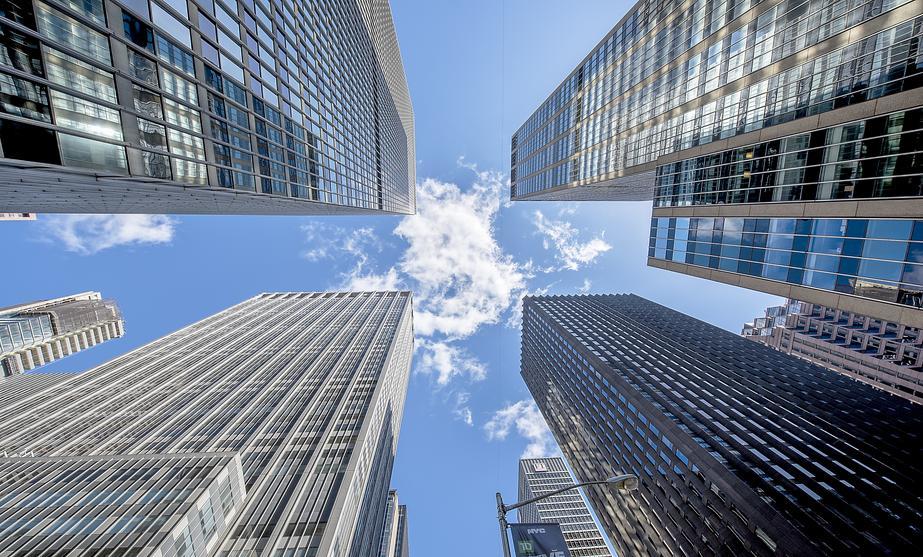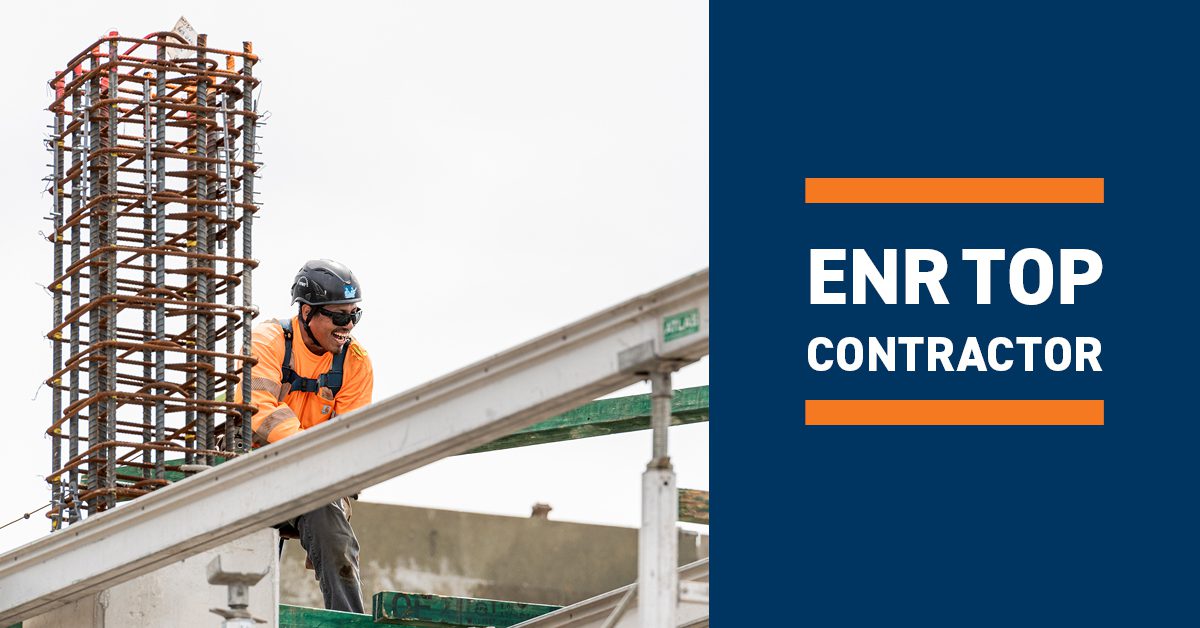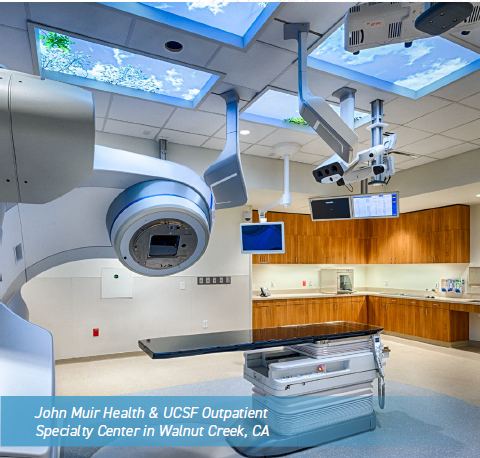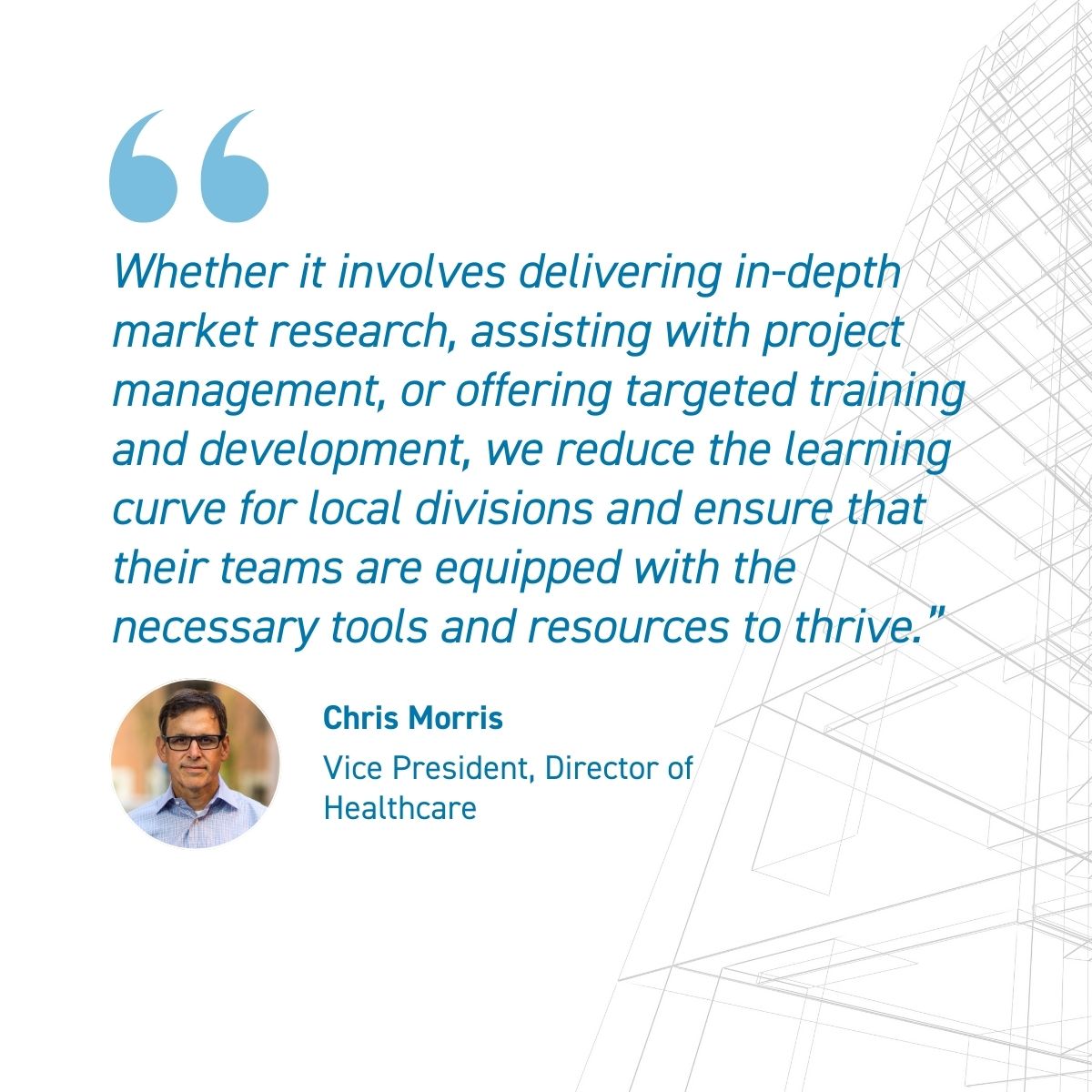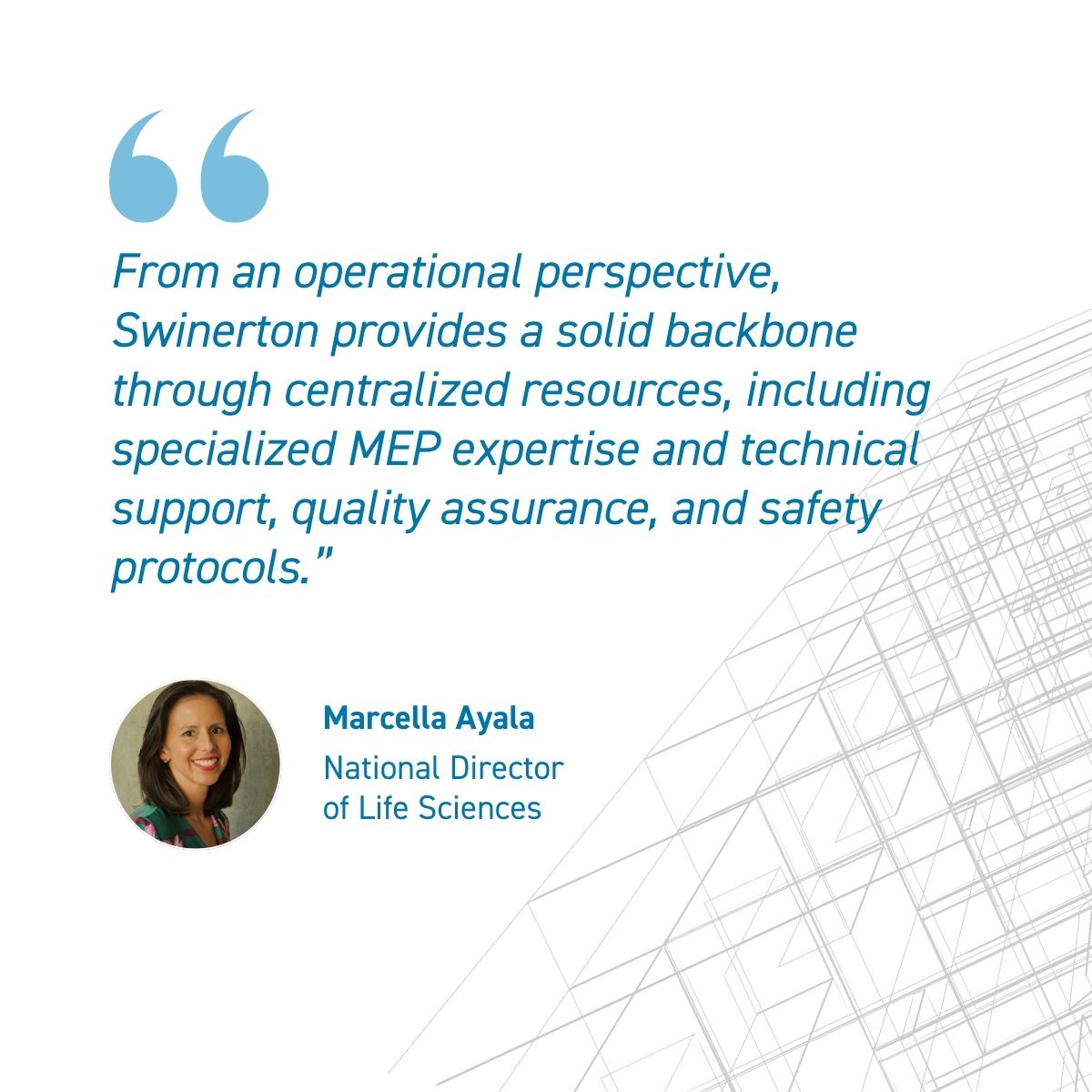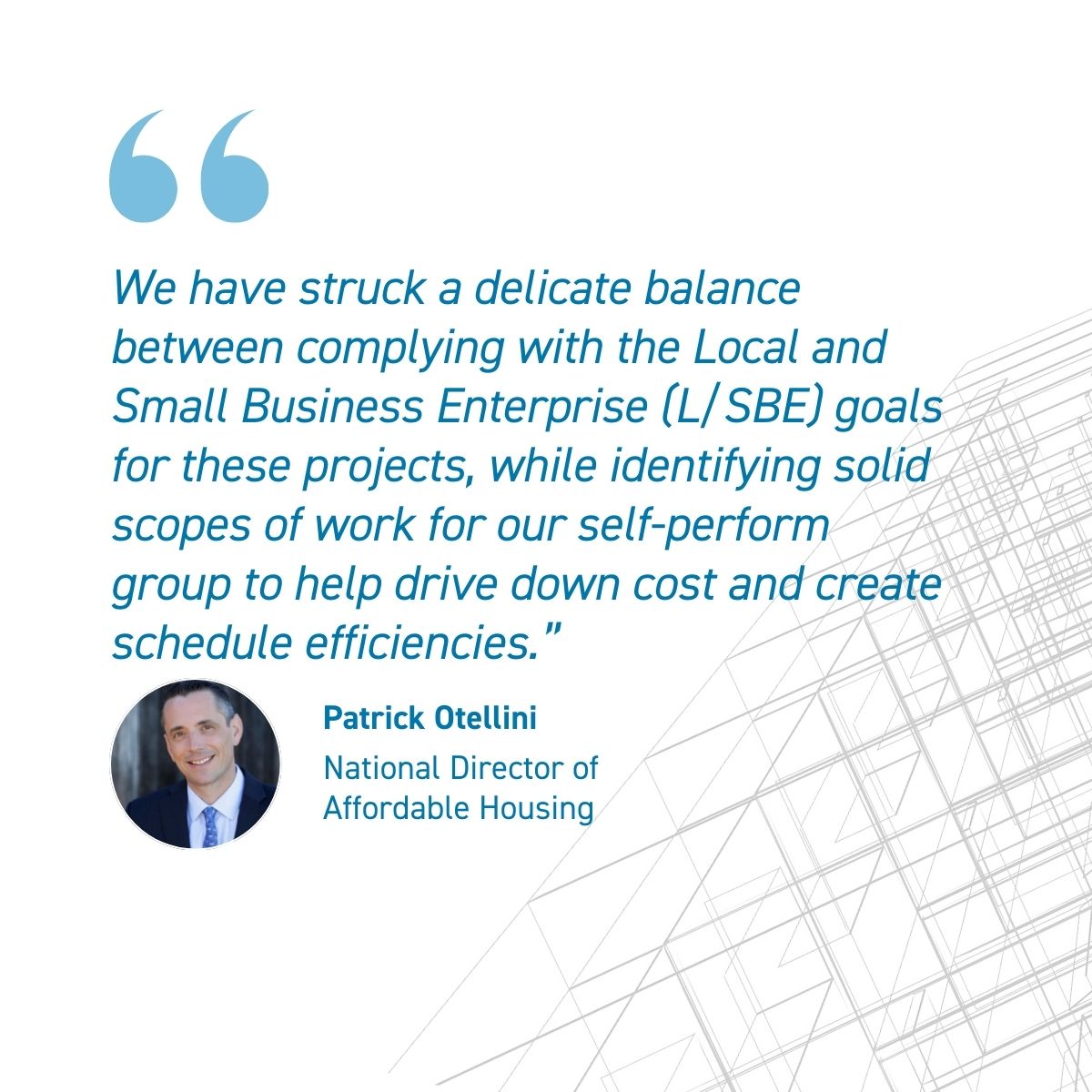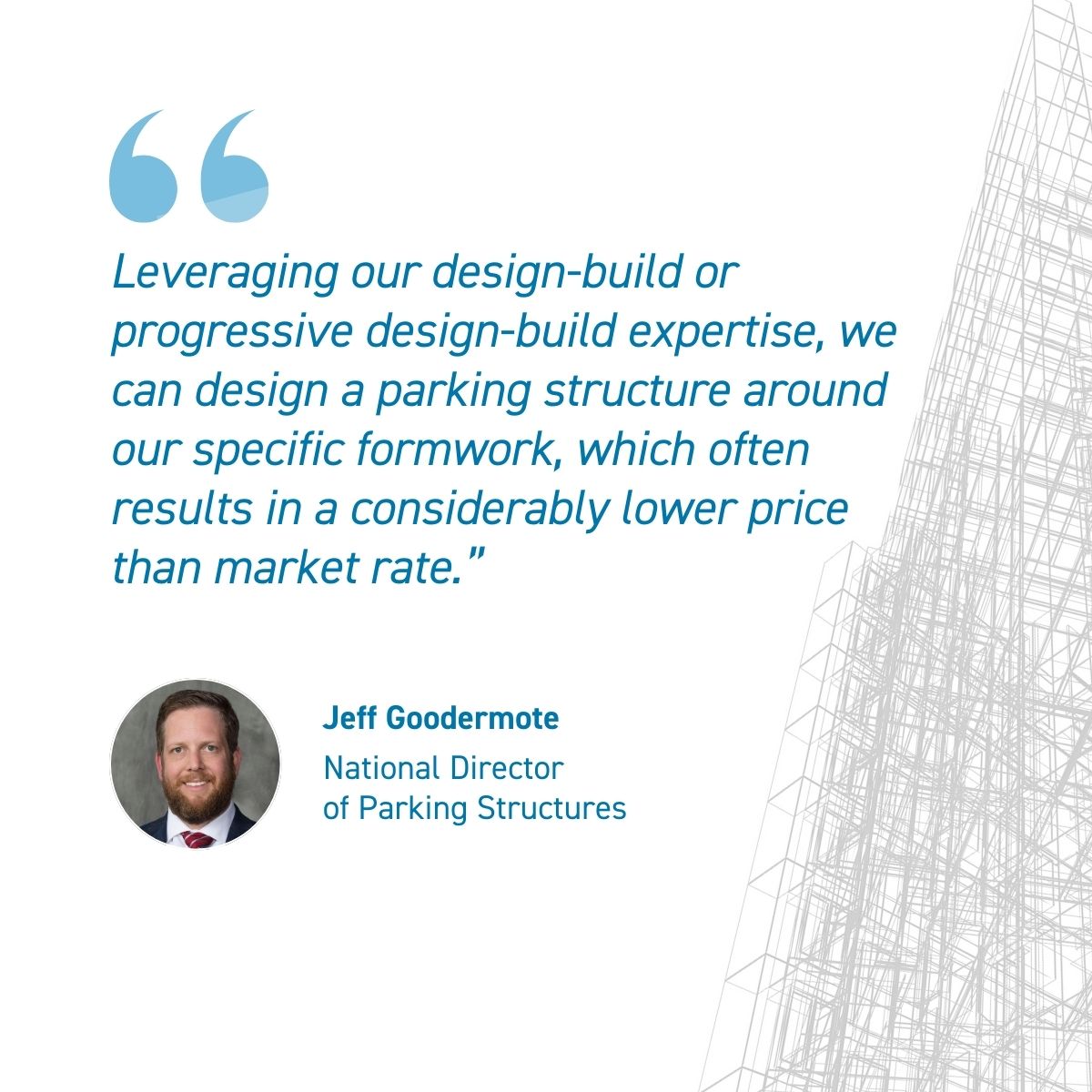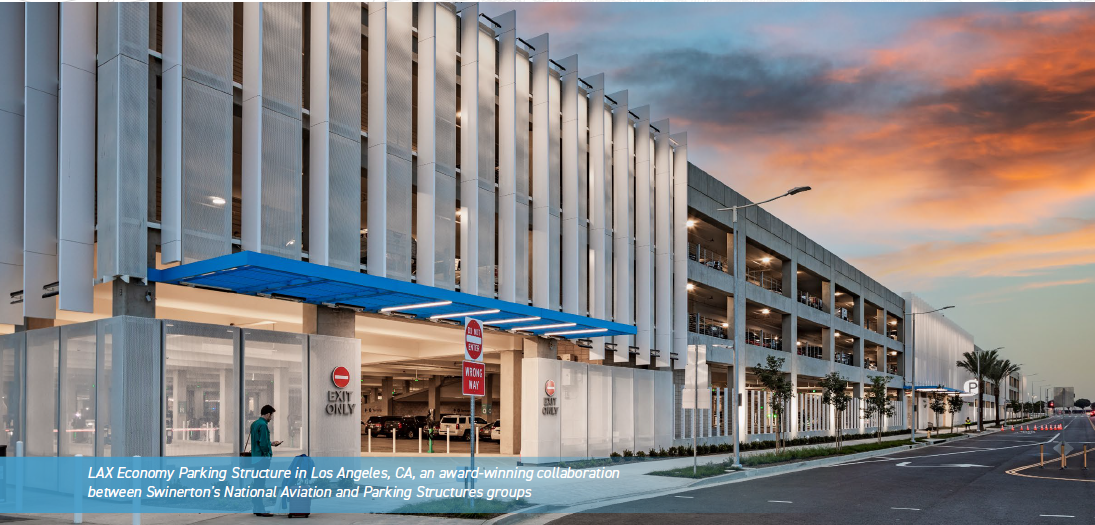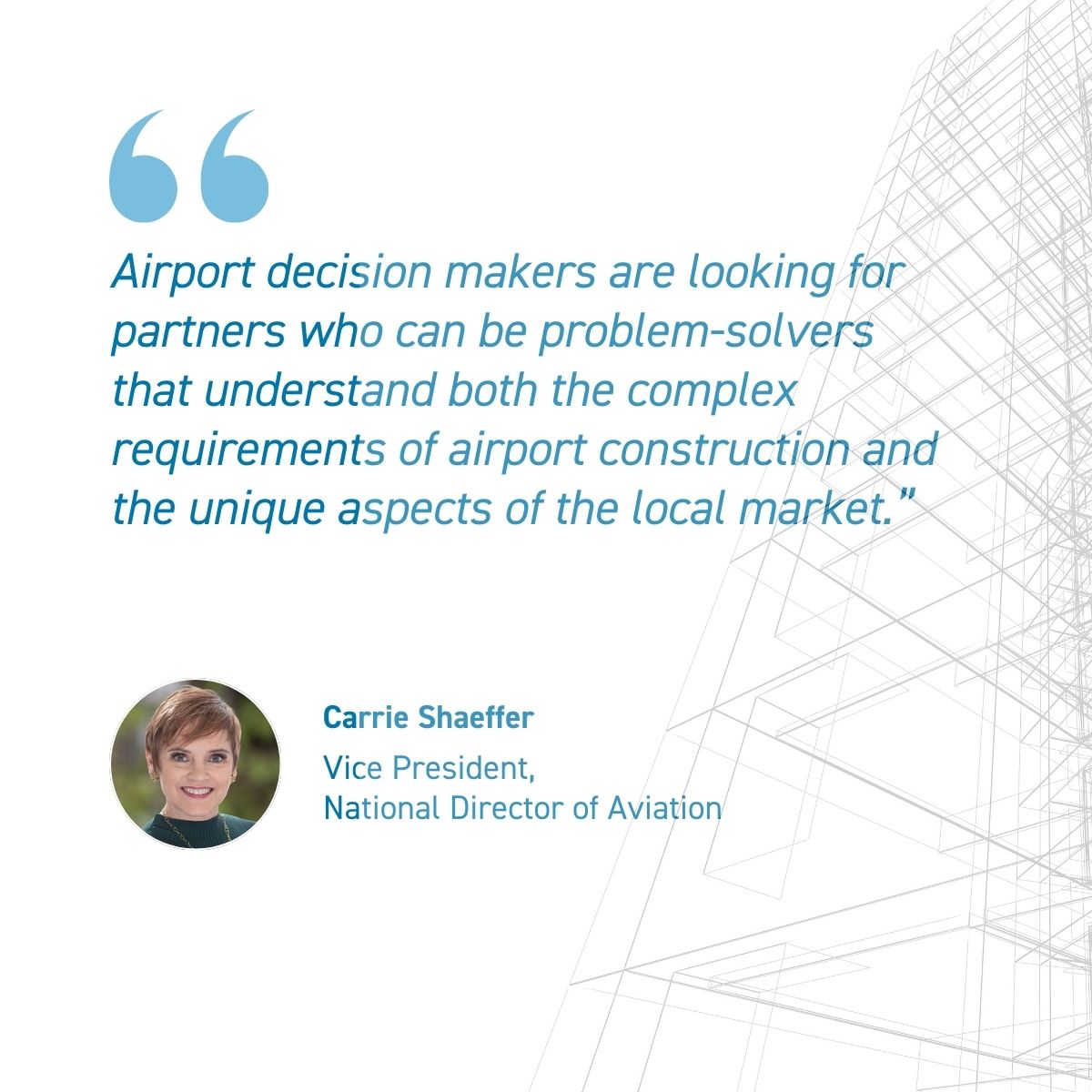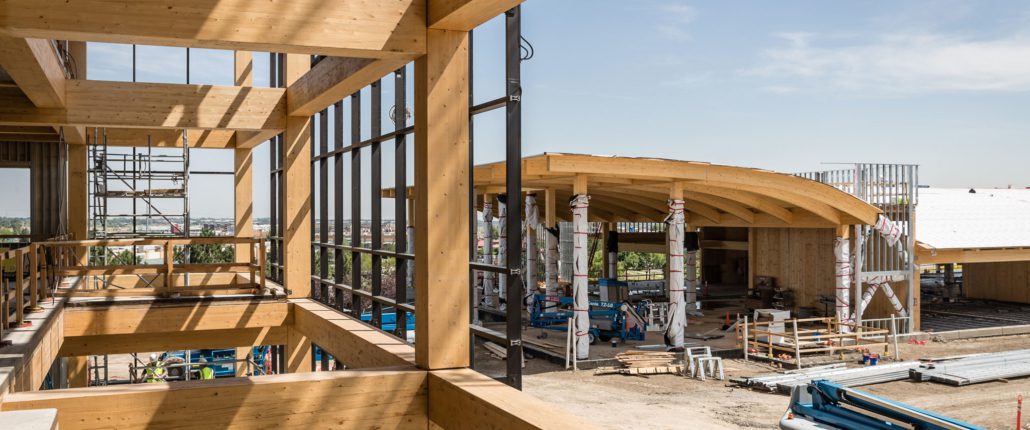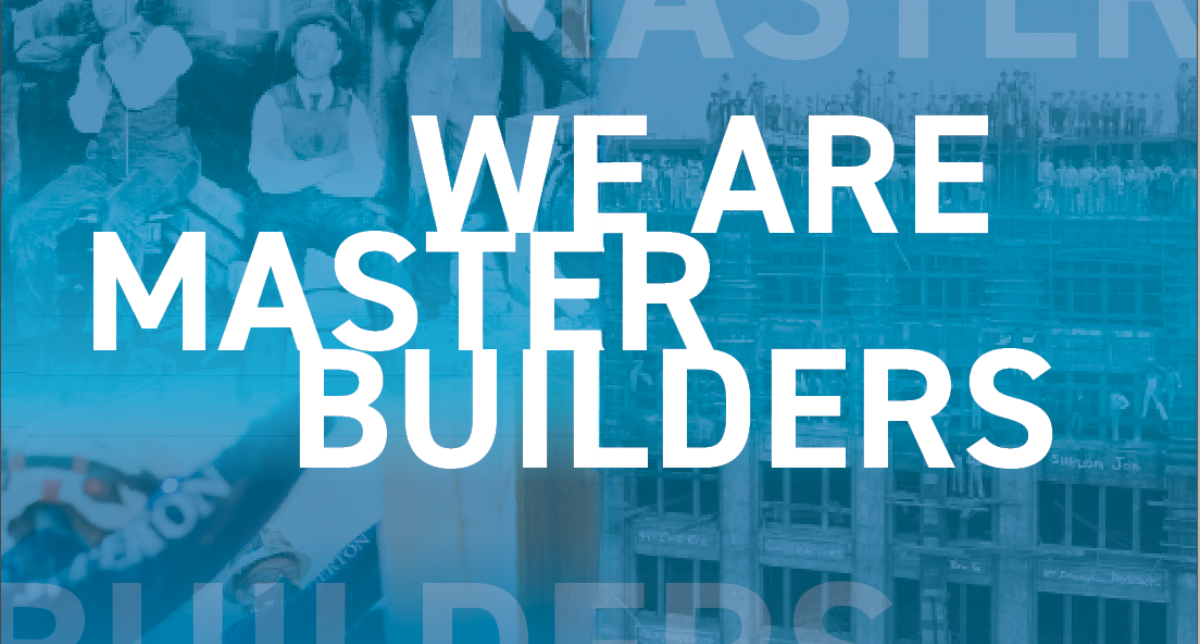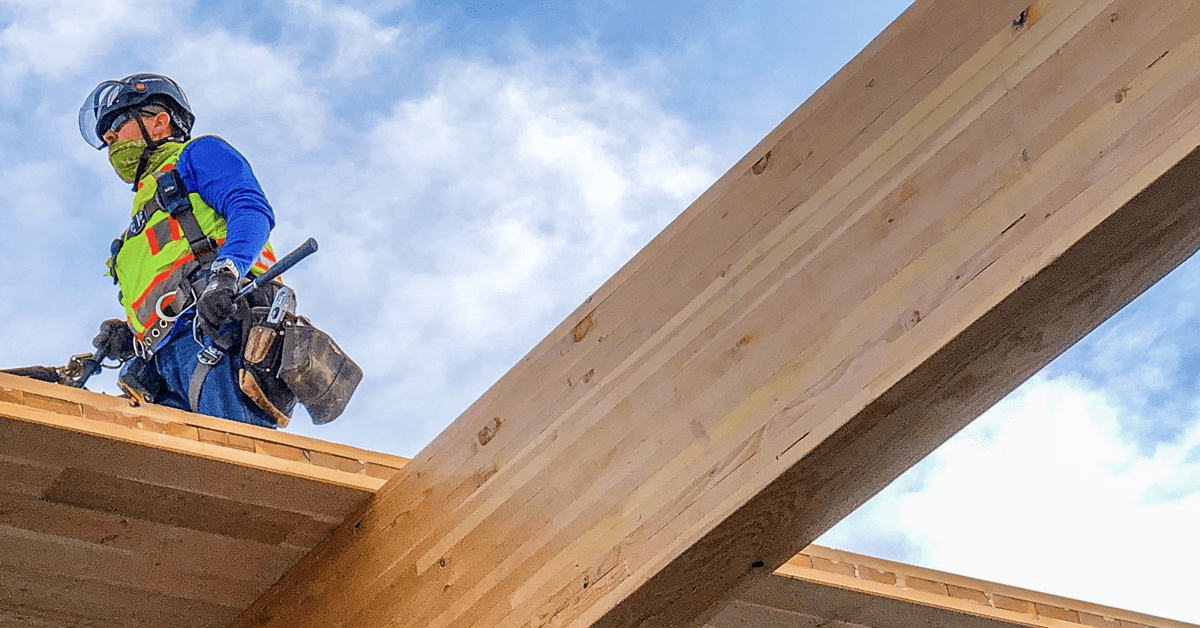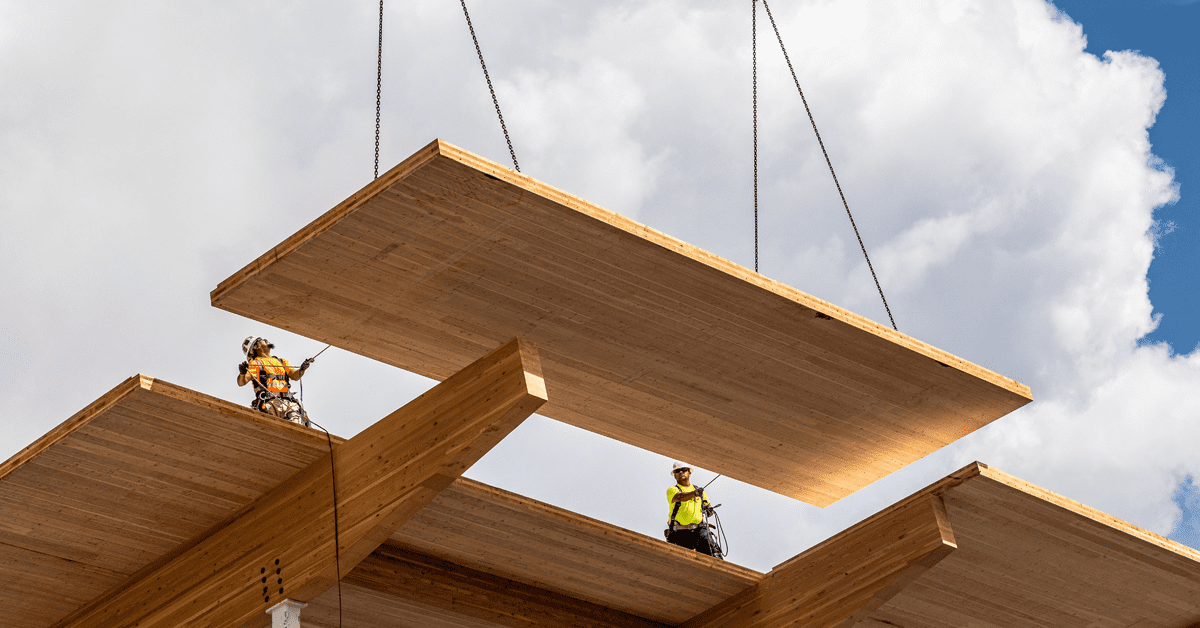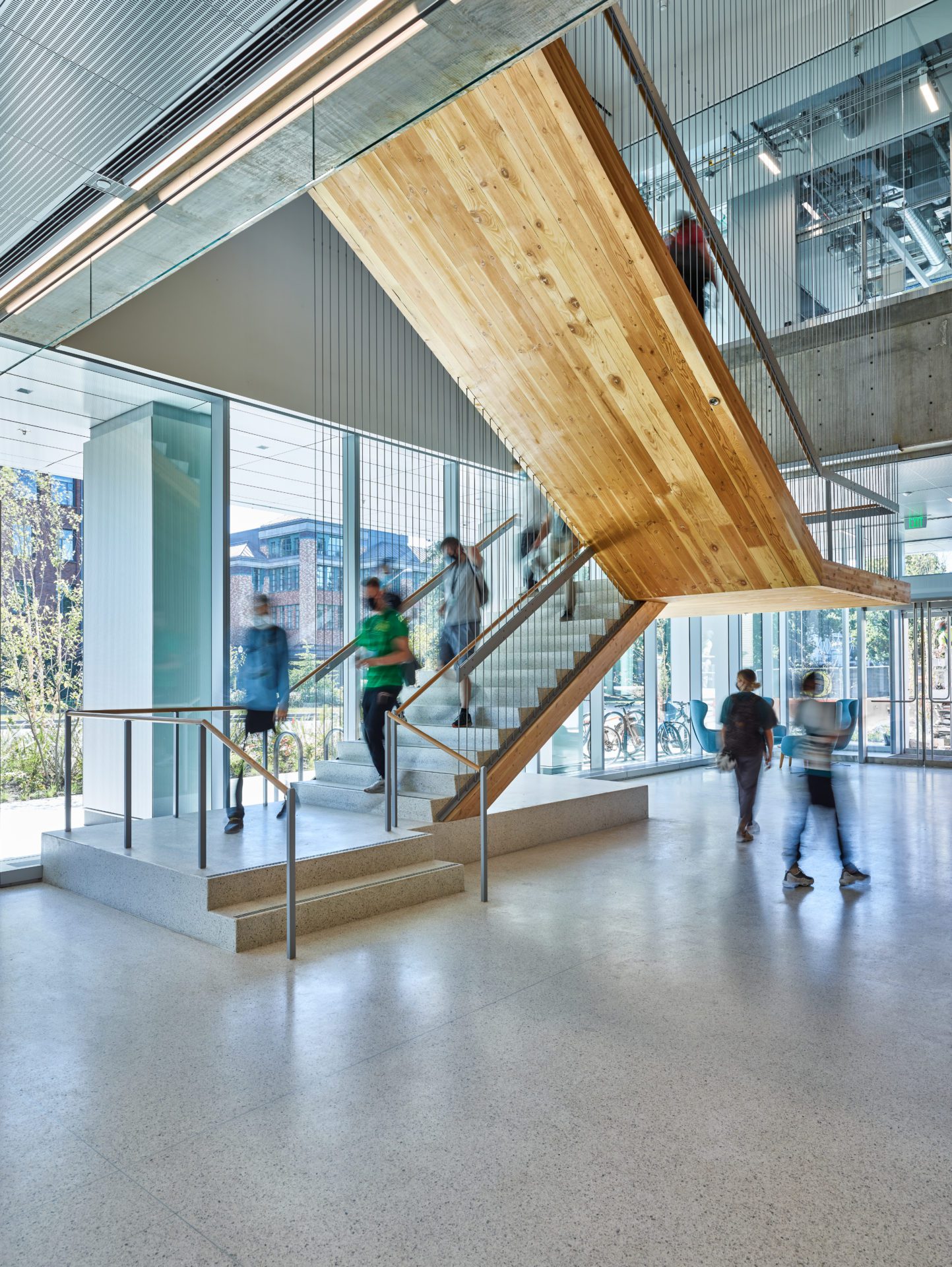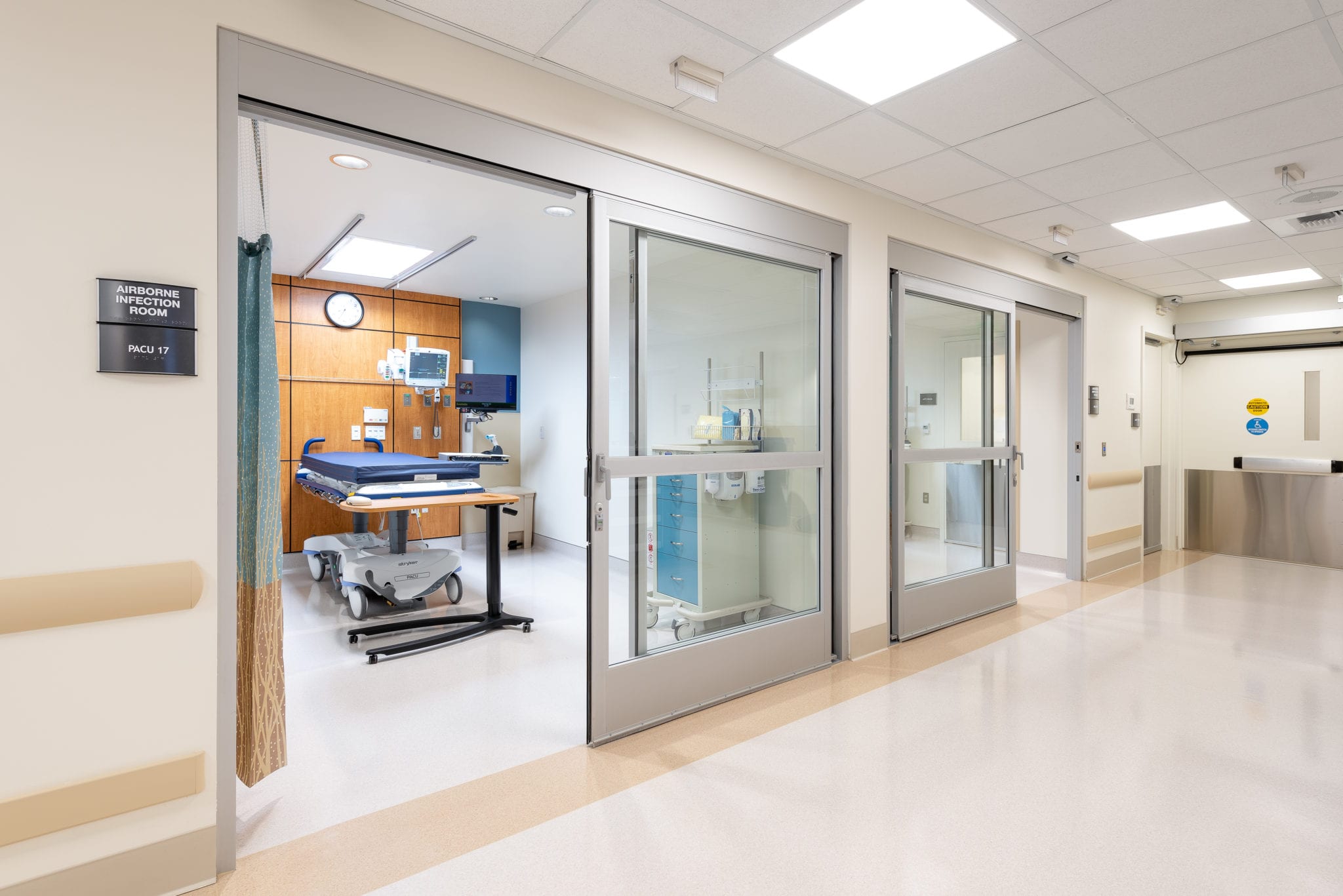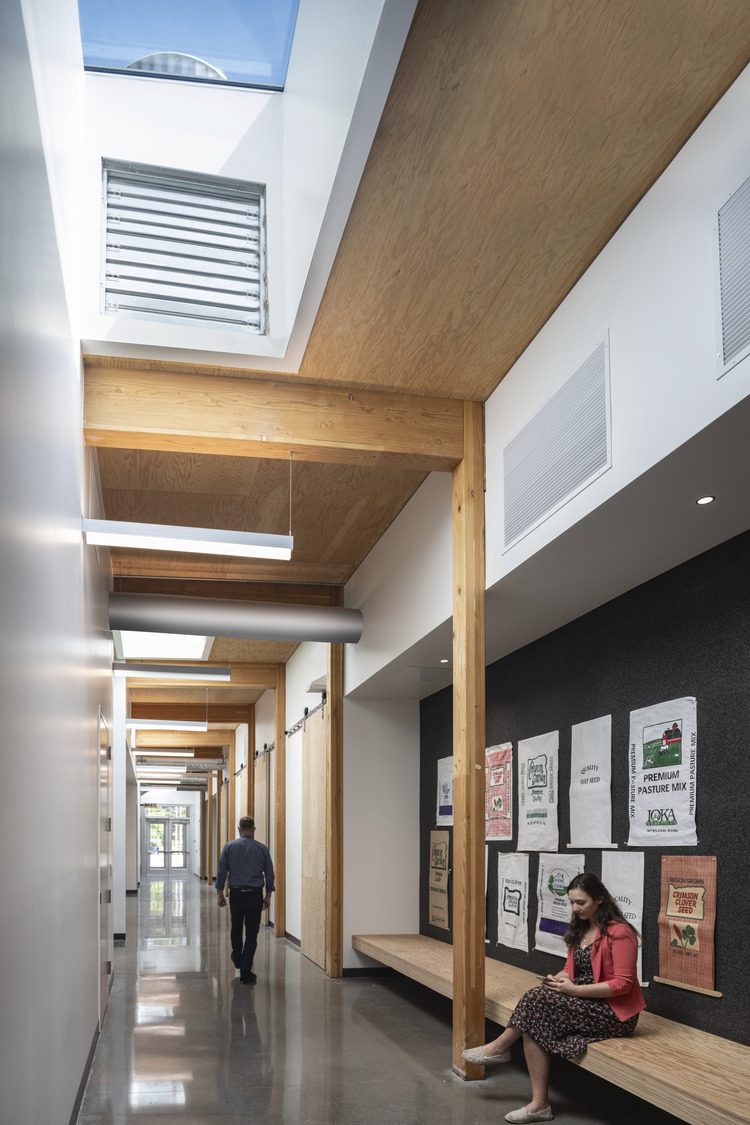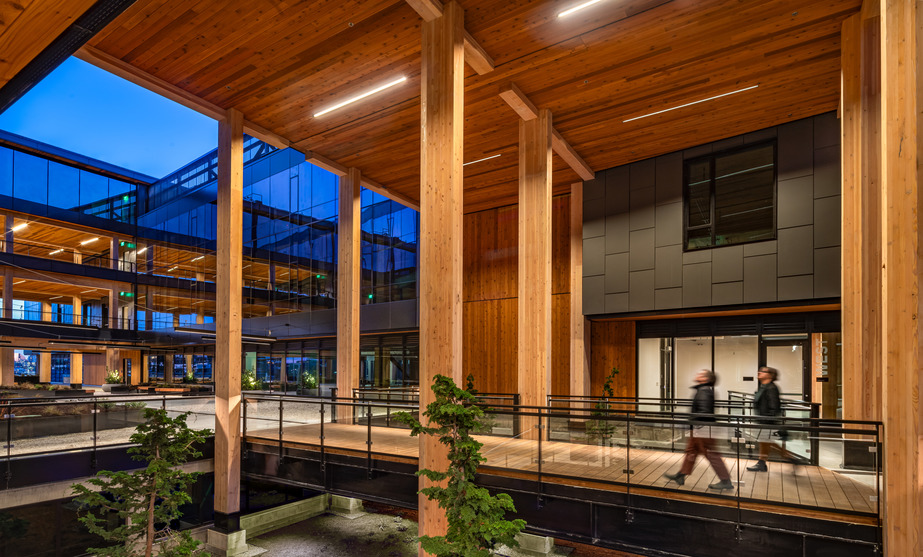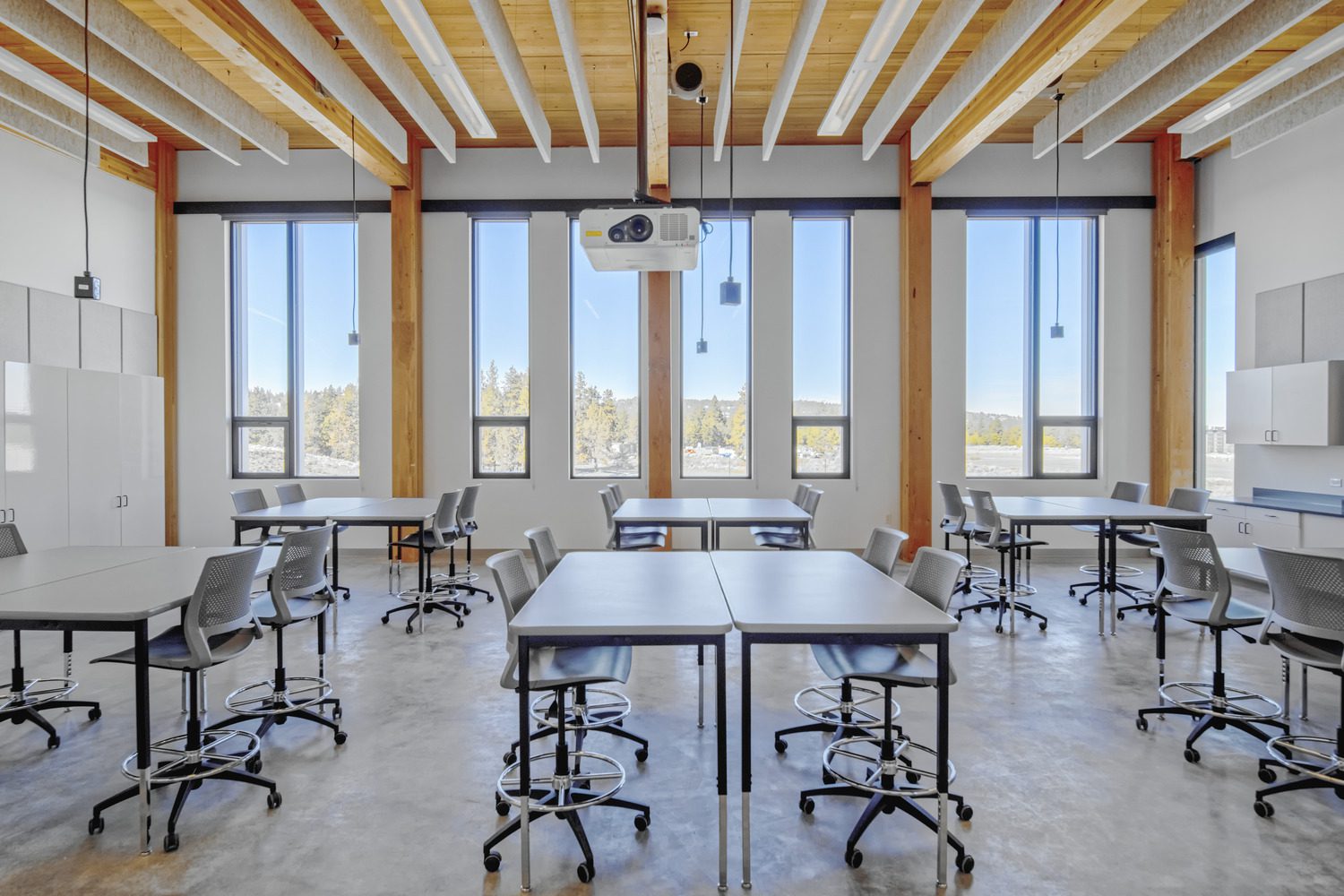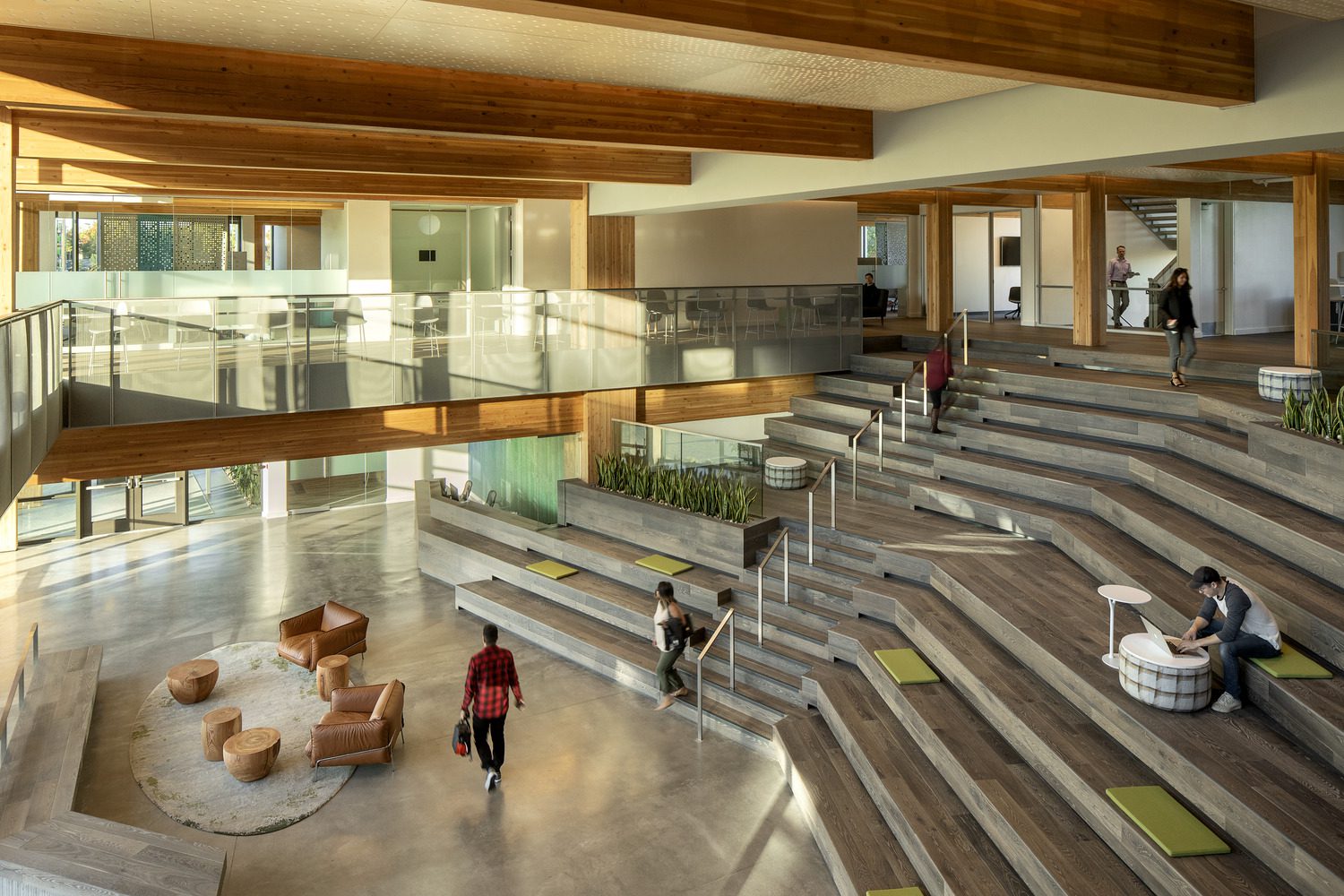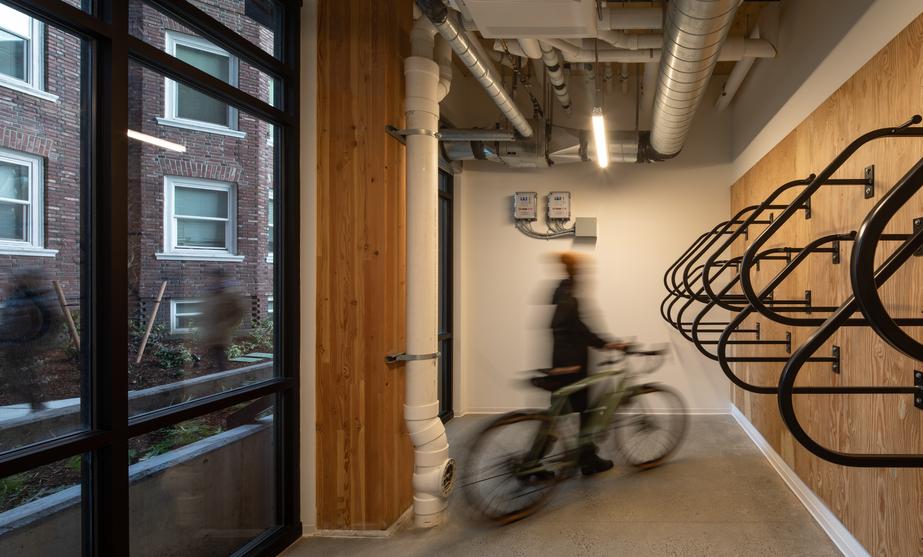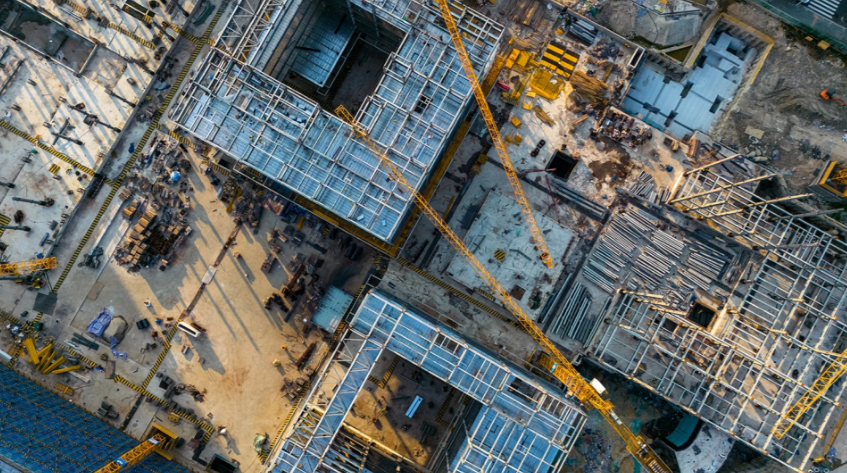Swinerton Fortifies East Coast Team With Additions to the New York Metro Division
Swinerton, a commercial general contractor with offices nationwide, is poised and ready for continued growth throughout the East Coast, bolstered by new talent in the New York Metro division. Swinerton expects construction projects along the East Coast will generate nearly $450 million of revenue in 2025, driving revenue growth for the firm’s regional divisions.
“Seven years ago, Swinerton landed on the East Coast with the opening of the Atlanta and Charlotte offices, and we haven’t slowed since,” said?Derek Mosiman, Vice President, Division Manager for Swinerton’s Atlanta division. “Collectively, the divisions along the East Coast have established their irrefutable reputations of deep knowledge across a variety of target markets, working for popular public companies, government entities, as well as Fortune 500 names in health care, education, hospitality, multifamily, and general business. Not only is our success attributable to our refined construction acumen, but also our distinctive culture. And now more than ever, we’re equipped to build our presence even more.”
The newest of Swinerton’s East Coast divisions is adding experience to support its growth and reinforce its foothold in New York and New Jersey. Joining the New York Metro division as Director of Client Relations is?Nicholas Schifferle. With 20 years of experience, Schifferle is in pursuit of commercial build opportunities throughout the tri-state area, particularly seeking public-private partnership (P3) and K-12 education opportunities.
Nick Dinallo?also joins the division as Project Executive with experience estimating, purchasing, and building over $1 billion of commercial projects across New Jersey with significant experience at?Terminal Construction Corporation. Dinallo leveraged his knowledge and passion for ground-up construction to the state of New Jersey’s first P3 development for Montclair State University.
“Nicholas is well known throughout our industry for his work across the United States and around the world, particularly in Thailand for JLL and Singapore, San Francisco, and New York for M. Moser,” said?Andrew Pearl, Vice President, Division Manager for Swinerton’s New York Metro division. “Where better to apply this diverse expertise than in the busiest city in the world? His established relationships enable Swinerton to pursue key client partnerships alongside our National Accounts teams.”
The post Swinerton Fortifies East Coast Team With Additions to the New York Metro Division appeared first on Swinerton.
]]>New Tool Helps Thousands of New York Condos Comply with Local Law 97
Over 50,000 residential buildings are affected by LL97, many owners face uncertainty about their compliance status.
According to Swinerton, one of the United States’ largest contractors, the law could be timber’s best chance to tap into a condo market traditionally dominated by steel and concrete. Swinerton – which owns Timberlab, one of the country’s largest mass timber fabricators – said LL97, combined with recent changes to the building code (allowing cross-laminated timber in Type IV buildings up to seven stories), could be the game changer for developers to use more timber in NYC:
“Swinerton has not only incorporated mass timber into new construction but also into tenant buildouts and renovations,”?said Andrew Pearl, Swinerton’s Vice President and Division Manager at its New York Office. “(And that’s because) The material is well-suited for everything from office and residential to public buildings.”
The post New Tool Helps Thousands of New York Condos Comply with Local Law 97 appeared first on Swinerton.
]]>Swinerton’s ENR Top 400 2025 National Rankings
Top 400 List Overall:?No. 30
Top 100 Contractors by New Contracts: No. 26
Top 50 in Domestic Building/Manufacturing Revenue: No. 14
Top 100 Design-Build Firms: No. 64
ENR West Contractor of the Year: Southern California
Swinerton’s ENR Top 400 2024 National Rankings
Top 400 List Overall:?No. 35
Top 100 Contractors by New Contracts: No. 22
Top 50 in Domestic Building/Manufacturing Revenue: No. 18
Top 100 Design-Build Firms: No. 64
Swinerton’s ENR Top 100 Green 2024?Rankings
Top 100 Green Building Contractors: No. 10
- Multi-Unit Residential: No. 4
- Retail: No. 4
Swinerton’s ENR Top 400 2023 National Rankings
Top 400 List Overall:?No. 29
Top 100 Contractors by New Contracts: No. 15
Top 50 in Domestic Building/Manufacturing Revenue: No. 16
Top 100 Green Building Contractors: No. 8
Top 100 Design-Build Firms: No. 58
Swinerton’s ENR Top 100 Green 2023?Rankings
Top 100 Green Building Contractors: No. 8
- Government Offices: No. 4
- Healthcare: No. 4
- Multi-Unit Residential: No. 4
- Retail: No. 4
Swinerton’s ENR Top 400 2022 National Rankings
Top 400 List Overall:?No. 21
Top 400 General Building:?No. 17
Top 400 Education:?No. 18
Top 400 Healthcare:?No. 18
Top 400 Retail:?No. 8
Top 400 Commercial Offices: No. 13
Top 400 Government Offices:?No. 12
Top 400 Hotels, Motels, & Convention Centers:?No. 6
Top 400 Multi-unit Housing:?No. 9
Top 400 Entertainment, Casinos:?No. 15
Top?400 Distribution & Warehouses: No. 20
Top 400 Airports, Including Terminals:?No. 11
Top 100 Green Building Contractors:?No. 3
Top 100 Contractors by New Contracts:?No. 7
Top 100 Design-Build Firms:?No. 16
Top 50 in Domestic Building/Manufacturing Revenue:?No. 17
Top 20 Contractors by Sector – Power:?No. 5
Swinerton’s ENR Top 100 Green 2022?Rankings
Top 100 Green Building Contractors:?No. 3
- Residential:?No. 5
- Retail: No. 2
Swinerton’s ENR Top 400 2021 Rankings
Top 400 List:?No. 17
- General Building:?No. 9
- Education:?No. 19
- Healthcare:?No. 13
- Retail:?No. 24
- Commercial Offices:?No. 6
- Hotels, Motels and Convention Centers:?No. 6
- Multi-unit Residential:?No. 6
- Government Offices:?No. 19
- Entertainment, Casinos:?No. 15
- Airports, Including Terminals:?No. 9
- Power:?No. 5
- Solar:?No. 1
Top 20 Contractors by Sector – Power:?No. 5
Top 100 Contractors by New Contracts:?No. 14
Top 50 in Domestic Building/Manufacturing Revenue:?No. 9
Top 100 Design-Build Firms:?No. 10
Top 100 Construction Management-at-Risk Firms:?No. 11
Top 100 Construction Management/PM-for-Fee Firms:?No. 86
Top 250 Global Contractors:?No. 77
Swinerton’s ENR Top 100 Green 2021?Rankings
Top 100 Green Building Contractors:?No. 3
- Commercial Offices:?No. 2
- Healthcare:?No. 2
- Multi-Unit Residential:?No. 2
- Retail:?No. 5
The post ENR Ranks Swinerton Among Top Contractors Nationwide appeared first on Swinerton.
]]>As a community contractor with national reach, Swinerton understands the unique demands of building some of our society’s most impactful and widely used infrastructure, including healthcare and life sciences facilities, housing for our vulnerable populations, and transportation hubs. Through vertical leadership and resources, we deliver the consistency and efficiency these market sectors require.
From our earliest days, Swinerton has lent our flexibility to a diverse array of product types and clients: from rebuilding hotels and commercial districts after natural disasters, to our expansion into complex industrial projects in the 20th century, to solidifying our place as a modern-day industry leader in sustainable mass timber construction.
Today, Swinerton is proud to provide premier commercial construction services to nearly 20 market sectors. Several of these markets—including Healthcare, Life Sciences, Affordable Housing, Aviation, and Parking Structures—comprise a large portion of our portfolio in multiple regions nationwide, necessitating centralized resources. These sectors are also essential to our daily lives, serving our society’s needs for health, shelter, and transportation.
To address the unique demands of these markets, Swinerton has centralized its resources and appointed National Market Leads to guide the overall focus and approach, enhance the consistency of project delivery from region to region, and reduce onboarding time for project teams by equipping them with the right training, resources, and processes to deliver on specialized market-specific needs.
To address the unique demands of these markets, Swinerton has centralized its resources and appointed National Market Leads to guide the overall focus and approach, enhance the consistency of project delivery from region to region, and reduce onboarding time for project teams by equipping them with the right training, resources, and processes to deliver on specialized market-specific needs.
“A national approach enables effective management, ensuring that we allocate resources where they are needed most,” says Chris Morris, leader of Swinerton’s National Healthcare market. “Recognizing that each division has its unique strengths and challenges, our team provides tailored support to address these specific needs. Whether it involves delivering in-depth healthcare market research, assisting with project management, or offering targeted training and development, we reduce the learning curve for local divisions and ensure that their teams are equipped with the necessary tools and resources to thrive.”
While projects across the country will always have regional considerations, such as different code requirements and jurisdictional agencies, many markets also have specific inherent industry needs that must always be considered no matter the project size, location, or complexity. For example, research-focused clients often operate in regulated, complex industries and require partners who understand the critical nature of their work, says Swinerton’s National Life Sciences Director, Marcella Ayala.
“From an operational perspective, Swinerton provides a solid backbone through centralized resources, including specialized MEP expertise and technical support, quality assurance, and safety protocols. These resources ensure that no matter where our Life Sciences clients’ projects are located, they receive the same high level of service and technical excellence that their industry demands,” Marcella adds.
As clients seek to answer what is next for their growth—whether rapidly expanding their own operations, or advancing their industry with new innovations—having a national, enterprise construction firm with the capabilities to answer a diverse set of needs is critical.
In addition to national quality and safety programs and centralized MEP expertise, Swinerton is capable of self-performing some of the most critical trades that drive a project, including concrete and drywall. In addition, the firm brings extensive mass timber expertise alongside the partnership of its mass timber affiliate, Timberlab. These capabilities can help drive cost and schedule efficiencies for many market sectors, but have proven especially valuable for affordable housing, where budget, community engagement, and sustainability are at the heart of nearly every project.
“Self-perform plays a huge role in this work,” says Patrick Otellini, Swinerton’s National Affordable Housing Director. “We have struck a delicate balance between complying with the Local and Small Business Enterprise goals for these projects, while identifying solid scopes of work for our self-perform group to help drive down cost and create schedule efficiencies. We also interface a lot with Timberlab, since many of these clients are looking at ways to build more sustainably.”
Recently, a Seattle-based architect who helped author changes to the 2021 International Building Codes (IBC) collaborated with Swinerton and Timberlab to build Seattle’s first mass timber mid-rise workforce housing structure under the new codes. The partnership testifies to how Swinerton’s integrated offerings are not only advancing the future of certain market sectors, but the construction industry as a whole.
Swinerton’s ability to self-perform work is also critically tied to the success of one of its largest national platforms: parking structures. Rather than a market in and of itself, Director of Parking Structures Jeff Goodermote refers to the structures he constructs as a specific “product” that intersects with and supports every other market that Swinerton works in.
“The parking structures sector is a little different from other market sectors, which may include different product types all under one umbrella. For example, aviation has landside and airside operations. Healthcare has acute and non-acute facilities. Compared to those markets, parking is a truly specialized, niche field,” Jeff says.
The group’s complete expertise in parking structure products can be largely attributed to the success of Swinerton’s self-perform concrete group, he adds.
“We have invested in a substantial amount of self-owned concrete formwork that is specific to concrete parking structures. Leveraging our design-build or progressive design-build expertise, we can design a parking structure around our specific formwork, which often results in a considerably lower price than market rate,” Jeff continues. “We have even shipped our formwork over the Pacific Ocean to deliver concrete projects in Hawaii. In addition to our extensive collaboration with our self-perform concrete teams, we are beginning to engage our drywall teams to self-perform some of the fa?ade treatments of our parking structures to round-off our thorough, end-to-end expertise in this product type.”
Over the past decade, the National Parking Structures group has delivered on a number of aviation parking structures throughout California and Colorado, not only bolstering its own portfolio but also the project experience of the National Aviation group. This has been a catalyst for success in other divisions, such as Texas and the Southeast. Additionally, intergroup collaboration between Swinerton’s national market platforms allows the firm to leverage its focus on enhanced efficiency, knowledge-sharing, and commitment to drive value by bridging often-fragmented scopes of work.
“Airport decision-makers are looking for partners who can be problem-solvers that understand both the complex requirements of airport construction and the unique aspects of the local market. We are thrilled to regularly partner with other Swinerton target markets like National Parking Structures,” says Carrie Shaeffer, National Director of Aviation.
“Clients benefit from a collaborative approach because we can provide innovative parking expertise and capabilities that also align with the specific nuances of sensitive airport environments informed by our National Aviation group,” Jeff adds.
Modern construction is demanding. Through our national market platforms, Swinerton ensures that our regional teams have the skills, resources, and support they need to tackle projects in a wide range of sectors. Furthermore, our coast-to-coast expertise and capabilities provide opportunities for clients seeking consistency and efficiency in their project delivery nationwide.
The post Delivering Crucial Infrastructure on a National Scale appeared first on Swinerton.
]]>Mass Timber Buildings: A New Approach to Sustainability and Net Zero Goals
Mass timber is quickly becoming a solution as the number of public institutions and private developers pledging to attain net-zero carbon emissions increases. Whether they are leaning on public-private partnership (P3) or traditional delivery methods, owners and developers are recognizing the benefits of wood as a versatile, sustainable, and structurally efficient feature for their projects. With public and private support for this renewable resource, experts believe mass timber could challenge steel and concrete as favored construction materials.
“Mass timber offers cost and value considerations that developers and clients see as benefits. Mass timber supports regional economies, saves time on the speed of construction, and is a renewable resource—with the added benefits of improved daylighting and interior aesthetics, which benefits the health and well-being of the end-user as well,” said Swinerton Builders (Swinerton) Pacific Northwest Regional Director of Preconstruction William Silva.
For example, at Northlake Commons, the utilization of mass timber estimates 1,990 metric tons of avoided CO2e (carbon dioxide equivalent) emissions, with a total carbon benefit of 2,920 metric tons; this is equivalent to removing 558 cars from the road or to the energy required to operate 249 homes for an entire year. It is also estimated that forests in the U.S. and Canada can regrow the equivalent wood volume in four minutes.
Swinerton’s early commitment to mass timber began in 2016 with the design, permitting, and construction of the then largest mass timber office building in the U.S.—First Tech Federal Credit Union Oregon Corporate Campus—which was delivered four months faster and four percent cheaper than structural steel.
In a short period, Swinerton has become known for taking on and successfully delivering some of the most challenging mass timber projects in the country. With the number of mass timber projects expected to double every two years, Swinerton has assembled an unparalleled knowledge base and robust internal resources that are sought after by design teams and owners who want to capitalize on the lessons learned from other projects.
While building designs will continue to push toward net zero energy, reducing operational carbon through better energy efficiency and cleaner energy sources, there is growing policy and regulation emphasizing the importance of reducing the embodied carbon of our infrastructure as well. Structure and foundation make up over half of a building’s embodied carbon footprint, so they are often targeted first for reductions. Every metric ton of wood used in place of concrete and steel in the structure is estimated to avoid 3.9 metric tons of CO2 emissions, and this is compounded by the fact that mass timber buildings are lighter and reduce the carbon (i.e., concrete) in the substructure.
Life-cycle assessment (LCA) is the industry tool for evaluating the embodied impacts of a building design, but what it cannot account for is the potential carbon “storage vault” mass timber infrastructure offers cities. Mature forests are maximizing their carbon storage, while growing forests are maximizing their carbon sequestration. By sustainably harvesting trees off the landscape and storing that carbon in wood structures for the life of the buildings, forests are allowed to sequester carbon more rapidly from the atmosphere and avoid releasing a large portion of the carbon stored in the removed trees.
While the softer benefits of mass timber, sustainability, and aesthetics frequently lead project teams to want to use a mass timber solution, the construction benefits are often what enables them to happen.
Swinerton recognizes the challenges of developing a project around a new structural system and brings its expertise to teams seeking creative solutions to make a mass timber project financially viable. Swinerton’s approach is to direct efforts toward reducing overall construction cost through smart and informed selections of not just the structural system but also to look at how to leverage complementary benefits in building mechanical, electrical, envelope, and interior systems to help achieve low energy goals.
“We can control costs through early assessment on project alignment with building code and efficient structural layouts that allow for complementary benefits with other building systems and maximize prefabrication,” added Silva.
Because Swinerton is a national leader in numerous construction market sectors, it combines market sector knowledge with mass timber advantages to bring beneficial outcomes for its clients. Swinerton has pioneered mass timber solutions in market sectors, including affordable housing, aviation, civic, community college, corporate accounts, healthcare, higher education, life science, office and more.
5 Examples of Swinerton’s Mass Timber Project Experience
Northlake Commons, Seattle, WA
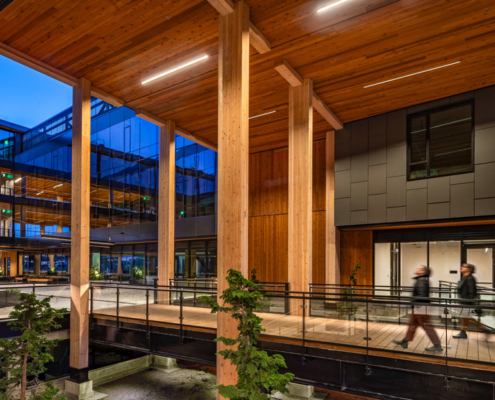
Swinerton’s Northlake Commons highlights the sustainability of mass timber in workplace construction. This 275,000-square-foot, LEED? Platinum-certified building incorporates mass timber columns, beams, and cross-laminated timber (CLT), showcasing how renewable materials can support both structural durability and environmental responsibility. Built in collaboration with Timberlab, a Swinerton affiliate, Northlake Commons’ timber was carefully chosen for its capacity to age beautifully while creating a warm, health-focused environment. Mass timber, significantly lighter than concrete and steel, reduces carbon emissions by up to 75%.
Beyond the use of wood, the building’s design maximizes water and energy savings, contributing to a 27% reduction in electricity usage and conserving over 700,000 gallons of water annually. Further, a significant 96% of construction waste was recycled, minimizing environmental impact. This commitment to sustainable mass timber not only enhances the building’s aesthetic and structural integrity but also reinforces Northlake Commons as a model for eco-friendly development in modern architecture.
Childcare Center, Boise, ID
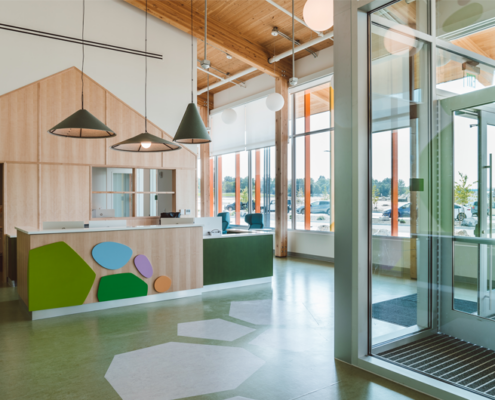
The new 19,347-square-foot single-story childcare center is a groundbreaking example of the benefits of mass timber in early education. Imagine nine lively classrooms with stunning vaulted ceilings, where clerestory windows flood the space with natural light, accentuating the warmth of timber columns and beams. Outside, timber overhangs create inviting play areas, blending seamlessly with nature.
This center isn’t just beautiful—it highlights sustainability. It combines mass timber with additional eco-friendly exterior materials, native landscaping, and cutting-edge energy-efficient features like low-VOC paint, smart thermostats, and LED lighting, seeking to achieve LEED? Gold certification. This innovative approach ensures a healthy, inspiring environment for children to learn and grow.
Sunnydale Community Center, San Francisco, CA
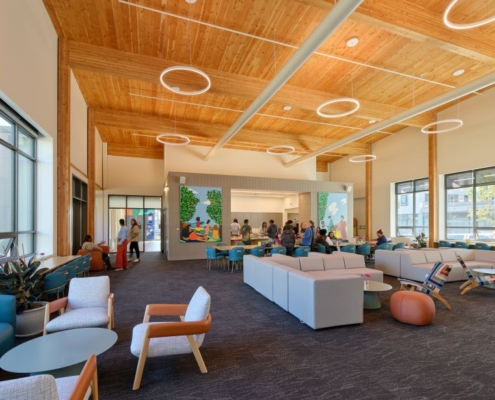
A vibrant new 30,000-square-foot neighborhood community center is a stunning two-story mass timber marvel. It offers a mix of spaces, such as a teaching kitchen, study areas, a recording studio, and a living room for community gatherings. The Sunnydale Community Center also hosts new facilities for Boys & Girls Clubs of San Francisco and Wu Yee Children’s Services, significantly boosting their capacity to provide childcare and youth programs.
Designed for LEED? Gold certification, the center emphasizes sustainability and biophilic design, using CLT and glulam for structural, aesthetic, and eco-friendly qualities. The exposed wood structure not only speeds up construction but also reduces waste and creates a warm, inviting atmosphere.
This project revitalizes the neighborhood, demonstrating the potential of mass timber construction and environmental responsibility with beautiful, impactful construction.
Live Oak Bank Building 4, Wilmington, NC
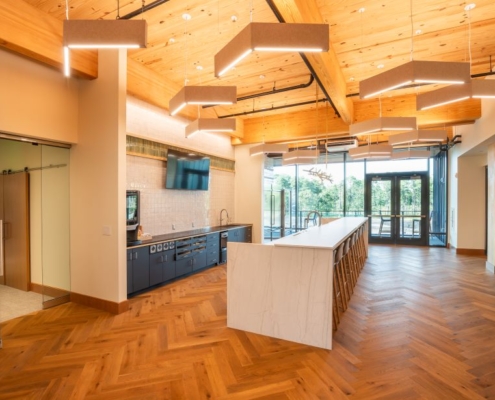 In Wilmington, NC, a new development is welcoming employees—a four-story, 67,000-square-foot constructed entirely from mass timber. This ambitious project is one of the largest of its kind in the United States, slashing the building’s carbon footprint by up to 60%. Nestled among trees and overlooking an expanded pond, Live Oak Bank Building 4 is a harmonious blend of nature and innovation. The design incorporates numerous biophilic elements, aiming to foster a happier, healthier, and more productive work environment. The building is on track to achieve LEED? Silver certification, highlighting its commitment to sustainability and eco-friendly design.
In Wilmington, NC, a new development is welcoming employees—a four-story, 67,000-square-foot constructed entirely from mass timber. This ambitious project is one of the largest of its kind in the United States, slashing the building’s carbon footprint by up to 60%. Nestled among trees and overlooking an expanded pond, Live Oak Bank Building 4 is a harmonious blend of nature and innovation. The design incorporates numerous biophilic elements, aiming to foster a happier, healthier, and more productive work environment. The building is on track to achieve LEED? Silver certification, highlighting its commitment to sustainability and eco-friendly design.Responsive Arts & STEAM Academy, Denver, CO
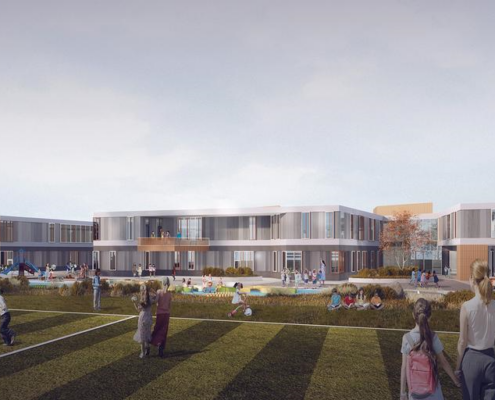
Additional Reading: Contractors are Partners for Achieving Sustainable Development Goals
The post Mass Timber Buildings: A New Approach to Sustainability and Net Zero Goals appeared first on Swinerton.
]]>WE ARE MASTER BUILDERS
Swinerton planted roots as a builder 135 years ago, and continues to deepen them nationwide. Alongside our subsidiary companies, we leverage our knowledge, skills, and drive to build the projects and workforce of the future. We take pride in the expertise and passion it takes to raise a structure from the ground up. Because, at our core, we are builders.
A CHANGING INDUSTRY
When brick mason Charles Lindgren founded the company that would become Swinerton at the end of the nineteenth century, the construction landscape looked very different than it does today. The industry was moving from a workforce of individual craftspeople managed by an architect or engineer to a more centralized system. Positions like those of superintendent and foreman emerged to be the expert eyes on the jobsite to manage installation and supervision, while contractor builders brokered materials, labor, and services.
An entrepreneurial mason turned builder, Lindgren saw the potential for greater speed and efficiency as technologies like steel-reinforced concrete emerged on the market. His business partner, Lewis A. Hicks, was a vocal advocate for this technology—writing two enthusiastic articles in 1905 for The Architect and Engineer of California and distributing brochures on the topic to local engineers.
When tragedy struck in the form of the 1906 San Francisco earthquake, Lindgren and Hicks were completely equipped to help rebuild, and could legitimately claim that their steel-reinforced concrete buildings fared better than most in the devastation. Clients who were initially skeptical of the “newfangled” material were convinced. By 1908, when namesake Alfred B. Swinerton joined the firm, the company was well on its way to becoming
one of the most recognized builders in the West, thanks in no small part to its expertise in concrete.
SEEING POTENTIAL
In the century that followed, Swinerton has continually invested in enterprises and people to keep the industry moving forward, expanding its markets and offerings nationally and internationally. From engineering canals and pipelines in the 1950s, driving value-add services like tenant improvements in the 1980s, to embracing sustainable materials and energies in the 2020s, we are always finding ways to build where the world is going.
In 2016, Swinerton recognized another opportunity: to drive construction forward by adopting mass timber. As a result, our mass-timber specialist subsidiary was launched in 2021, harnessing the structural and environmental potential of engineered wood materials and helping clients meet their vision for sustainable structures that soar with the beauty of timber.
BUILDERS OF TOMORROW
Being a master builder depends on first-hand knowledge of the builder’s craft, which must be passed down with each generation. We continue our 135- year builder’s legacy by supporting the workforce of the future: training the next generation of craftspeople in trade skills, and attracting more builders to the industry.
Through The Swinerton Foundation’s support of trade education programs at the Cypress Mandela Training Center in Oakland, CA, Portland YouthBuilders in Portland, OR, and The Roc in Charlotte, NC, partnership with organizations like SkillsUSA nationwide, and outreach efforts at colleges and universities, we are driven to support the young people who will become our next generation of master builders.
OUR BUILDER’S LEGACY
Alongside the industry’s evolution, at Swinerton we continue our master builder’s legacy through the present day, employing thousands of expert craftspeople on staff as laborers, journeymen, foremen, and superintendents whose direct experience in the field ensures our projects’ success. As a company, we invest in their safety, their training, and their well-being to ensure their expertise shines on every project.
Swinerton Builders’ self-perform teams include concrete, drywall, doors, frames and hardware, carpentry, millwork, and demolition and clean-up. Our family of companies also includes a broad range of professionals whose expertise encompass concrete at SAK Builders, mass timber at Timberlab, and engineering, procurement, and construction of renewable gas plants at Swinerton Energy.
On every project, we also draw on our experts who understand the non-physical components of building: financing, logistics, planning, permits, site entitlements, and more. Our administrative teams at Swinerton, Lindgren Development, and Griffin Swinerton work in tandem to make our clients’ buildings possible.
Combined with our expert knowledge and skill, our pride of ownership, passion, leadership, integrity and excellence are what truly make us master builders.
The post We are Master Builders appeared first on Swinerton.
]]>WHY MASS TIMBER IS EARNING A PLACE IN HEALTHCARE CONSTRUCTION
HEALTHY BUILDINGS FOR A HEALTHY PLANET:
Original Post: 12/2022 | Revision 2 06/20/24
The use of?mass timber?in commercial building projects continues to double in growth each year as a low-carbon, sustainable and light-weight structural material compared to traditional construction materials. Mass timber was already popular in Europe, which accounts for over 60% of the global market for this innovative construction material, but its adoption is now becoming increasingly widespread across North America. According to the Wood Products Council, as of March 2024, 2,115 multi-family, commercial building, and institutional projects featuring mass timber are underway or completed in the United States, reflecting a steady growth trend.
Mass timber is prized by architects, builders and environmentalists alike. When exposed in building designs, the material’s beauty is immediately apparent. As a structural element, mass timber can meet or even exceed concrete and steel construction performance standards. Its most important benefit, however, is its potential contribution as a climate change solution.
While steel and cement manufacturing are among the world’s largest sources of carbon emissions, a mass timber-framed building can serve as a carbon sink throughout its lifetime, sequestering carbon absorbed from the atmosphere while the wood was growing in the forest. As long as the building stands, the carbon contained in the wood remains locked in the structure and will not be released into the air.
“Conversations around sustainability in the building industry used to be focused on operational energy, the carbon emissions associated with a building’s use from heating and cooling, for example,” said Tanya Luthi, director of engineering at Timberlab. “That understanding has evolved to include the full life cycle of a building, including the embodied carbon of the materials used to construct the project. Fortunately, advancements in engineered wood products, such as the development of cross-laminated timber, have coincided with a strong and deepening commitment to sustainable forestry practices, allowing us to use mass timber responsibly at scale from an engineering and a sustainability perspective. Wood is the only major structural material that we can regrow.”
Because of these climate benefits, governments and municipalities across the U.S. and worldwide are establishing policies that promote the use of mass timber in new construction. A recent example is New York City’s Mass Timber Accelerator program, which is piloting the use of mass timber in a series of large-scale construction projects across the city to align with its decarbonization efforts.
At the same time, many jurisdictions are revising building codes to permit the use of mass timber in ways that previously wouldn’t have been considered. These changes have enabled the construction of revolutionary new buildings like the Ascent in Wisconsin. At 25 stories and 284 feet tall, this residential tower in the heart of Milwaukee’s downtown is the world’s tallest hybrid mass timber building.
Despite the rapid growth in enthusiasm for mass timber construction across multiple industries, the healthcare sector has been slower to adopt this climate-friendly material. Concerns about medical space planning, infection control, acoustics and vibration suppression — among other issues — have inhibited the healthcare industry’s transition to mass timber structures.
However, this reluctance is fading as new projects — including an ambulatory care unit in Sechelt, British Columbia and Northlake Commons, a life sciences laboratory and workspace building in Seattle — demonstrate mass timber’s enormous potential to revitalize the construction of healthcare facilities. Besides mass timber’s obvious environmental benefits, its use is also proven to contribute to patient and employee well-being and bolster the brand reputation of its earliest adopters.
In the months and years to come, it will be increasingly important for leading organizations in the healthcare industry to demonstrate their commitment to the health of the planet and their communities by choosing the building material that best aligns with their mission — to improve human health.
WHY MASS TIMBER? THE GROWING FOCUS ON SUSTAINABILITY, SOURCING TRANSPARENCY AND ETHICAL BUILDING AND CONSTRUCTION
Among stakeholders in healthcare, as well as a broad array of other industries, there is growing awareness of the climate impact of constructing new buildings and facilities. World Green Building Council estimates that the built environment is responsible for 39% of global carbon emissions. Cement and steel manufacturing industries account for nearly 10% of the world’s ongoing carbon emissions, a source of carbon dioxide that’s difficult for societies to eliminate. On average, approximately 2 tons of carbon dioxide are emitted in manufacturing every ton of steel, though this can be reduced somewhat by incorporating scrap into recycled steel production.
In contrast, trees capture and store carbon as they grow — approximately 1 ton for every cubic meter of growth. By weight, trees are approximately 50% carbon. When trees are harvested, all the carbon that has been sequestered in the wood while they were growing remains there. Once that harvested wood is used in a building that carbon will stay within that structure for as long as the building stands. In essence, mass timber construction projects transfer sequestered carbon from forests to the built environment. Then, new trees are replanted in place of those harvested, capturing and storing yet more carbon.
This fact accounts for the environmental promise of mass timber construction. Mass timber is a renewable resource. Plus, it’s possible to store embodied carbon within a building for the whole of the structure’s lifecycle. Research indicates that mass timber construction is approximately 50% more carbon-efficient than steel.
But this is a rule-of-thumb estimate. The actual climate impact of any individual mass timber construction project will be influenced by the forestry, transportation and milling practices employed for the wood used in the project, as well as how the building is disassembled and its materials disposed of at the end of its life cycle.
For a truly sustainable building project, using locally sourced wood from sustainably managed forests is necessary. Not only do intact forest ecosystems sequester more carbon, but they also help protect biodiversity and wild animal habitats. It’s key to cultivate transparency and accurate tracking in the mass timber supply chain to ensure that building materials are sourced from responsibly managed forests.
For instance, sourcing wood for building projects in the Pacific Northwest from forests in the same region makes sense because it reduces the distance construction materials need to be transported, thereby reducing emissions. This practice also supports the region’s historically important timber economy and rural communities, which are integral to the timber supply chain.
In addition, it’s crucial to select timber harvested from timberlands that grow trees to a size large enough to ensure that the maximum rate of carbon sequestration has occurred on those forested lands. Timber producers that exceed state Forest Practices Act guidelines for sustainable forestry practices and watershed health adhere to climate-smarter practices.
MASS TIMBER IN OUTPATIENT HEALTHCARE FACILITIES: AN IDEA WHOSE TIME HAS COME
To date, mass timber has not been widely used for structural systems in healthcare industry construction projects. This means there are few examples to validate that mass timber can meet healthcare facilities’ unique structural requirements. However, research and innovation are underway, and ongoing studies demonstrate that mass timber can meet the strength and performance requirements necessary for its adoption in healthcare.
VIBRATION CRITERIA
Buildings in the healthcare sector must meet strict vibration requirements to support the performance of critical operations and sensitive medical equipment. Typically, this means that structures are designed to be stiffer and more robust, adding material and expense to the project. Vibration performance in mass timber buildings can be challenging due to the structure’s lightweight, so healthcare operators are wondering if mass timber structures can meet the requirements. New vibration analysis tools, coupled with field testing of occupied buildings, have shown that mass timber-framed structures, just like steel structures, can be designed to meet or exceed the vibration criteria for operating and treatment rooms, patient rooms, administrative and public areas, medical offices and lab areas.
ACOUSTIC REQUIREMENTS
Sounds in healthcare environments can range from the beeping of alarms and equipment to the hum of machines and HVAC systems to other people’s conversations. These can irritate or even harm patients, and transferring these sounds can violate patient privacy required by HIPAA (Health Insurance Portability and Accountability Act). Healthcare facilities require conscious design for strategic sound control, and mass timber elements have lower sound ratings because of their lower mass relative to concrete. For this reason, timber panels are complemented by other materials in a floor assembly that can add mass and ensure noise control. Laboratory tests have shown that mass timber floor assemblies can achieve acoustic performance that meets industry guidelines.
INFECTION CONTROL
Healthcare facilities have strict surface-cleaning and sanitization requirements, particularly in high-risk areas such as operating rooms and intensive care units. In these areas, surfaces must be resistant to microbial growth and spread, smooth, nonporous and durable enough to withstand repeated cleaning and disinfection. In critical facilities such as surgical suites in mass timber buildings, wood can be encapsulated with materials and finishes that create a sterile and durable surface, like what is done in concrete and steel buildings. In less critical facilities, the wood can be coated with a washable finish.
FIRE PREVENTION AND SUPPRESSION
There’s a common misconception that wood is inherently dangerous in fires. However, mass timber is not a lightweight wood frame construction, and like a log in a campfire, mass timber buildings have inherent fire resistance due to their size. Though still a combustible material, mass timber structures are designed and built to achieve the same fire and life safety requirements as non-combustible construction.
In fact, cross-laminated timber and glulam members have demonstrated compliance with local and international building codes. Unlike steel, which will lose strength if it becomes too hot, mass timber building components will incur surface charring but retain strength to sustain design loads. In addition, mass timber beams and columns designed to inhibit floor-to-floor and room-to-room smoke transfer have earned smoke ratings comparable to those of steel structural elements. Fire risks in mass timber buildings can be additionally mitigated with encapsulation or through other compensating measures, such as improved egress design, more reliable and robust suppression systems and early fire detection measures.
COST CONCERNS
In the past, some stakeholders have avoided mass timber because they perceive it as inherently more expensive. While it can be true that there are higher material costs associated with building and framing in mass timber, these costs are generally offset by shorter material lead times, faster structure installation, and a shortened construction schedule overall.
“Timber structures can be built faster, but that is only advantageous when projects are planned and managed correctly. The biggest financial risk in any construction project will always be the labor cost, which is highly dependent on how much time the project takes. Delays are generally more expensive than changing materials, resolving conflicts or altering designs. Mass timber project timelines are more predictable, which makes the capital investment more predictable,” states Erik Benedetti, project manager and healthcare lead at Swinerton.
Some stakeholders have also avoided using mass timber because of concerns about the cost or availability of insurance. Because this is an emerging technology, not all insurers may understand mass timber’s performance and benefits. It may be necessary to engage and communicate with your underwriter to help them understand and accurately assess the risks. This issue will almost certainly become rarer as mass timber adoption accelerates.
ENSURING BETTER PATIENT EXPERIENCES TO IMPROVE CARE OUTCOMES
Healthcare stakeholders increasingly recognize that providing high-quality patient care goes beyond supplying the right medications, technologies and evidence-based therapeutic protocols. Optimizing patient outcomes also requires providing care that respects individuals’ preferences, emotional needs and values. It means treating patients in spaces purposefully designed to make occupants feel healthy and safe. In this arena, mass timber construction truly shines.
The aesthetic and design benefits of exposed wood in architecture are already well understood. As award-winning architect Michael Green, who builds mass timber structures in British Columbia, said, wood is “nature’s fingerprint in buildings,” so mass timber has a deeply soothing effect on the buildings’ occupants.
Biophilic design is among the latest trends in hospital and healthcare facility design. A growing body of research shows that incorporating natural elements or views of nature in healthcare facilities can improve staff productivity and efficiency while enhancing patients’ feelings of well-being, decreasing stress levels and reducing pain levels. Studies have shown that hospital patients whose rooms have views of forested land or water recover more quickly than those with views of a blank wall. They require less pain medication and leave the hospital earlier. Mass timber construction with exposed structural elements can bring that impression of nature into the healthcare facility. Plus, if patients are told the building’s story, they’ll understand the positive impact its construction has had.
“Awareness of the impact of climate change is growing among patients today,” said Chris Morris, director of national healthcare at Swinerton. “Knowing that the building where you’re receiving care was built from materials that were sourced locally, that are more sustainable and that are contributing to sequestering carbon from the atmosphere is significant for many people. The beauty of mass timber is just one more reason they’d prefer to receive care in those buildings.”
While leading healthcare organizations are designing healthcare spaces to feel welcoming, artful and beautiful rather than sterile or clinical, they’re also thinking about ways to extend the benefits of design aesthetics to their employees. In a field where record shortages of nurses and other skilled professionals are an acute problem, it’s particularly important to design employee break rooms and common spaces in ways that are restful and calming to help counter burnout.
Furthermore, patients and employees alike appreciate when a healthcare organization’s commitment to sustainability and ethical building practices allows it to operate harmoniously with its mission of promoting human health and healing.
CONCLUSION
Today’s healthcare organizations face numerous challenges. They must recruit and retain top-notch care providers, deliver high-quality patient care and streamline operations to manage costs. To build thriving practices that will attract patient populations now and continue to do so in the future, they must demonstrate that they care for the minds, bodies and spirits of patients, caregivers, administrators and visitors. This requires more than medical expertise; it also demands vision and the courage to make sustainable and ethical choices.
“The stakes are high in an industry like healthcare – we are talking about people’s lives,” said Luthi. “When the stakes are high, people are often cautious about change, which could be one reason we haven’t seen mass timber adopted as widely in healthcare as in other sectors. But if you look at it another way, incorporating mass timber into healthcare projects is actually the perfect opportunity to make a positive impact both on the planet and on its people.”
The post WHY MASS TIMBER IS EARNING A PLACE IN HEALTHCARE CONSTRUCTION appeared first on Swinerton.
]]>MASS TIMBER:A SUSTAINABLE REVOLUTION SHAPING THE FUTURE OF CONSTRUCTION
By Andrew Pearl
For years, innovators have applied cutting-edge technologies to enhance wood’s key qualities. Products such as glued laminated timber (glulam) have been manufactured for over a century to make durable timber in complex shapes, while rigid and dimensionally stable products such as cross-laminated timber (CLT) are relatively new to the North American market. These products offer builders tremendous potential for innovative design, structural stability, cost efficiency, schedule efficiency and sustainable building.
ENVIRONMENTAL IMPACT
The 2023 International Mass Timber Report illustrates how mass timber can propel the North American construction industry toward its sustainability goal of carbon neutrality by 2034. With its low carbon footprint and ability to sequester carbon dioxide (CO2), mass timber has the potential to significantly reduce global CO2 emissions associated with construction activities.
Mass timber mitigates climate change in three ways:
1. Carbon sequestration: trees, through photosynthesis, capture CO2 from the atmosphere, reducing the overall CO2 in the atmosphere.
2. Carbon storage: wood and other bio- based materials retain CO2 in long-term applications instead of being released into the environment through decomposition or combustion. When amassed sufficiently, the cumulative carbon sequestered can potentially surpass that of an unmanaged forest.
3. Carbon substitution: mass timber, with 30% to 50% fewer CO2 emissions compared to traditional concrete and steel structures, provides a compelling alternative, steering clear of high-embodied carbon materials.
INNOVATION AND VERSATILITY
Mass timber lends itself to innovative applications where standard materials or techniques may prove too heavy or expensive. Its unique combination of strength and light weight make mass timber ideal for projects such as tall buildings, which require greater stability. The comparative weight advantage is staggering. A timber building, on average, weighs only 20% as much as its concrete or steel counterpart. This advantage is especially significant for sites with poor soil conditions, pressure limitations or high seismic activity, where a lighter building could be built larger and taller than a heavier building without compromising stability.
MASS TIMBER AND THE FUTURE OF CITIES
With its intrinsic sustainability, reliability and aesthetic appeal, mass timber promises to be the future of construction. To move urban environments into a greener future, contractors must engage with city and state regulatory agencies to advocate for updates to building codes that support the use of mass timber in commercial buildings.
Swinerton’s Heartwood project in Seattle exemplifies the power of this collaborative approach. Heartwood is Seattle’s first mass timber middle-income housing development, challenging traditional building practices via a new, replicable typology for mid-rise residential projects. The project utilizes CLT with exposed glulam columns and beams and is the first Type IV-C tall timber building entitled through the City of Seattle under the newly adopted 2021 International Building Codes (IBC), following the exact IBC provisions by design.
The West Coast is not the only place experiencing a mass timber breakthrough. A 2022 update to the New York City Building Codes explicitly provides for mass timber elements, aiding Local Law 97’s goal to establish carbon neutrality in the city by 2050 — one of the country’s most ambitious plans for reducing emissions. Additionally, the New York City Economic Development Corporation launched the New York City Mass Timber Studio this year to support the development of mass timber projects in their early phases.
Since Swinerton expanded its operations into New York City in 2021, the firm has been at the forefront of the new opportunities. Also breaking into the East Coast scene is Timberlab, a wholly owned entity of Swinerton Incorporated offering design-build mass timber services.
The mass timber firm recently opened its East Coast glulam fabrication facility — located in Greenville, South Carolina — to build on the momentum of mass timber adoption across the eastern United States and to tap into the abundance of durable and fast-growing southern yellow pine, which has emerged as the preferred species for many architects.
THE FUTURE UNVEILED
The push for sustainable buildings and cities is dramatically shaking up the construction landscape, and regulatory updates are finally beginning to recognize the cost savings, improved sustainability and streamlined construction benefits that position mass timber as an integral piece of the movement.
The future of wood-based construction lies in reimagining and reclaiming one of the world’s oldest building materials to provide sustainable economic growth and preserve the environment. But to do this, firms need to remain nimble, adaptable and open to whatever comes next in the dynamic world of mass timber construction.
The post MASS TIMBER: A SUSTAINABLE REVOLUTION SHAPING THE FUTURE OF CONSTRUCTION appeared first on Swinerton.
]]>EXPLORING THE FUTURE OF MASS TIMBER INSIGHTS FROM NYC TIMBER TALKS PRESENTED BY SWINERTON
Swinerton, a general contracting and construction management leader, hosted the insightful NYC Timber Talks event last week at Haworth New York Showroom. The event featured a panel of experts in the construction industry with a focus on mass timber.??
Featured speakers, including Andrew Pearl (Swinerton), Charles Besjak (SOM), Eli Gottlieb (Thornton Tomasetti), Gizem Karagoz (New York City Economic Development Corporation), Taylor Landry (Woodworks), and Tanya Luthi (Timberlab), brought their expertise to the forefront, dispelling myths and inaccuracies surrounding mass timber. They delved into the current and past mass timber applications, shedding light on its safe and innovative usage and exploring the vast opportunities for future developments in this sustainable construction material.?
“At Swinerton, we recognize the critical importance of uniting stakeholders across the construction industry to collectively address and overcome the challenges we face, including headwinds and misinformation about sustainable materials like mass timber,” stated Andrew Pearl, Vice President and Division Manager of Swinerton’s New York location. “The NYC Timber Talks event underscored our commitment to fostering collaboration and transparency, ensuring that together, we can advance construction practices that are not only environmentally responsible but also align with the highest safety standards. By working hand in hand, we’re setting the stage for a future where sustainable construction materials like mass timber are understood, valued, and utilized to their full potential.”?
The panel highlighted the transformative power of mass timber in the construction industry, emphasizing its role in significantly reducing carbon emissions by up to 40% compared to traditional steel structures. This innovation aligns perfectly with New York City’s ambitious emission reduction targets and the directives of Local Law 97, marking a pivotal shift towards more sustainable building practices. Furthermore, mass timber introduces an unprecedented level of transparency in timber sourcing. Thanks to advanced tracking systems, every piece of timber can be traced back to its source, providing deep insights into sustainable timber production and fostering responsible growth in the sector. This dual benefit of environmental impact reduction and supply chain transparency positions mass timber as a critical component in the future of eco-conscious construction.?
Tanya Luthi, Director of Engineering at Timberlab, highlighted how the rigorous fire testing done on mass timber at Timberlab will revolutionize the fire code across all buildings. She stated, “We’re testing multiple methods of fire resistance, seeing how techniques like the char method can interact with non-combustible finishes to extend burn times by 50%. We’re making mass timber just as safe if not safer than the fire code currently permits.”???
Mass timber has just as much a place in city development as steel, as seen with the success of Boston’s Mass Timber Accelerator program. The Ascent project in Milwaukee, Wisconsin, a 25-story mass timber hybrid residential high-rise, demonstrates mass timber’s potential for building tall. Elli Gottlieb, Managing Principal at Thornton Tomasetti, noted that mass timber’s potential in cities is not limited to tall buildings, as the majority of New York City’s buildings are only six stories.??
NYC Timber Talks made it clear that mass timber is here and it is here to stay. The possibilities are endless, and with Swinerton and Timberlab’s continued commitment to research, this is just the beginning.??
The post EXPLORING THE FUTURE OF MASS TIMBER INSIGHTS FROM NYC TIMBER TALKS PRESENTED BY SWINERTON appeared first on Swinerton.
]]>NYCEDC Releases Circular Design & Construction Guidelines, an Operational Guide to Reduce Embodied Carbon in NYC’s Built Environment
Seven Project and Development Teams Selected to Participate in New York City’s First-Ever Mass Timber Studio Program
New York City Economic Development Corporation (NYCEDC) today announced the advancement of two key commitments featured in New York City’s?Green Economy Action Plan?that seek to revolutionize a green path forward for cleaner construction and low carbon buildings with the launch of the?Clean and Circular: Design and Construction Guidelines?and the selection of the first design and development teams of the NYC Mass Timber Studio.
Key to New York City’s decarbonization efforts, the?Clean and Circular: Design and Construction Guidelines, offer an operational guide to reduce waste and embodied carbon in New York City’s built environment. Additionally, NYCEDC awarded seven design and development teams to participate in the?NYC Mass Timber Studio,?a first-of-its-kind program in New York City, announced in September 2023. The technical assistance program is designed to support active mass timber development projects in the early phases of project planning and design. Mass timber is a natural, renewable and sustainable material with a lower carbon footprint than traditional building materials like concrete and steel.
The full list of NYC Mass Timber Studio awardees include:
- Mass Timber in Harlem – Harlem, Manhattan:?Project evaluating the viability of converting an existing design of a six/seven-story residential building from a concrete superstructure to a lower carbon mass timber superstructure. The project team includes atelierjones, Magna & York, Sage and Coombe, Swinerton, Timberlab, and DCI Engineers.
The post NYCEDC Advances Two Key Commitments in NYC’s Green Economy Action Plan to Decarbonize Buildings, Construction appeared first on Swinerton.
]]>
